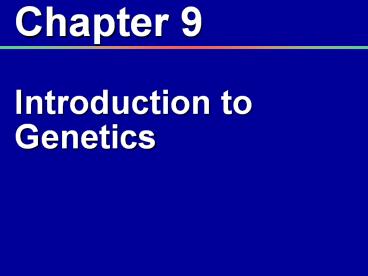Chapter 9 Introduction to Genetics - PowerPoint PPT Presentation
Title:
Chapter 9 Introduction to Genetics
Description:
Chapter 11 Introduction to Genetics Gregor Mendel (Father of Genetics) Mendel s Garden Mendel studied garden peas Mendel carried out some cross-fertilization Cross ... – PowerPoint PPT presentation
Number of Views:366
Avg rating:3.0/5.0
Title: Chapter 9 Introduction to Genetics
1
Chapter 9Introduction to Genetics
2
- Gregor Mendel (Father of Genetics)
- Was the first person to analyze patterns of
inheritance - Deduced the fundamental principles of genetics
Figure 9.4
3
Seven characteristics of pea plants studied by
Mendel
Dominant
Recessive
Dominant
Recessive
Pod shape
Flower color
Constricted
Inflated
White
Purple
Pod Color
Green
Yellow
Flower position
Axial
Terminal
Stem length
Seed color
Yellow
Green
Tall
short
Figure 9.7
Seed shape
Round
Wrinkled
4
Mendels Garden
- Mendel studied garden peas
- These plants are easily manipulated
- Self-fertilize
Stamen
pistil
Figure 9.5
5
- Mendel carried out some cross-fertilization
Removed stamens from purple flower
White
Stamens
Parents (P1)
Transferred pollen from stamens of white flower
to pistil of purple flower
pistil
Pollinated ovary matured into pod
Planted seeds from pod
Offspring (F1)
Figure 9.6
6
Cross Fertilization of Parents
Pollen
Cross-Fertilize
Pollen
P
P
True-breedingPurple-floweredParent
True-breedingWhite-floweredParent
F1
All Purple-floweredOffspring (hybrid)
7
Monohybrid cross cross between hybrids for one
trait such as flower color
F1
75 Purple25 White
Self-Fertilize
F2
F2
F2
F2
8
Genes, Alleles, Loci (specific location on a
chromosome where a gene is found) and Chromosomes
Chromosome from One Parent
t
C
F
locus has gene that controls leaf color. Plant
homozygous dominant for this gene
locus has gene that controls plant height. Plant
homozygous recessive for this gene
locus has gene that controls fruit shape. Plant
heterozygous for this gene
t
f
C
Homologous Chromosome from Other Parent
9
(No Transcript)
10
Using a Testcross to Determine an Unknown Genotype
- A testcross is a mating between
- and individual of unknown
- genotype and
- a homozygous
- recessive individual
Testcross
Genotypes
P_
pp
Two possibilities for the purple flower
Pp
PP
P
Gametes
p
P
p
P
Pp
pp
Pp
Offspring
All purple
1 purple 1 white
Figure 9.12
11
Rules of Probability
- Probability affects inheritance (Example)
- Coin toss probability of heads ½, the outcome
of any particular toss is unaffected by what
happened on previous attempts. - Each toss is an independent event
- The probability of a compound event is the
product of the separate probabilities of the
independent events. (example ½ x ½ ¼) - Rule of Multiplication
12
The Rules of Probability
F1 Genotypes
B b female
B b male
- The rule of multiplication
Formation of eggs
Formation of sperm
The probability of a compound event is the
product of the separate probabilities of the
independent events
1/2
B
B
1/2
1/2
B
B
b
b
1/4
1/2
(1/2 ? 1/2)
b
B
B
b
1/4
1/4
b
b
F2 Genotypes
1/4
Figure 9.13
13
Dihybrid CrossSsYy X SsYy
SsYy x SsYy
Eggs
SsYy Parent Self-fertilizes
SY
Sy
sY
sy
14
14
14
14
SY
14
116
116
116
116
Key Smooth S Wrinkled s Yellow Y Green y
SSYY
SSYy
SsYY
SsYy
Sy
14
116
116
116
116
SSyY
SSyy
SsyY
Ssyy
Sperm
sY
14
116
116
116
116
sSYY
sSYy
ssYY
ssYy
sy
14
116
116
116
116
sSyY
sSyy
ssyY
ssyy
14
(No Transcript)
15
(No Transcript)
16
Family Pedigrees
Recessive Traits
Dominant Traits
- Mendels principles apply to the inheritance of
many human traits
Freckles
No freckles
Straight hairline
Widows peak
Free earlobe
Attached earlobe
Figure 9.14
17
Incomplete Dominance
- Inheritance in which, an active allele does not
entirely compensate for an inactive allele - When the heterozygous is intermediate between the
two homozygous phenotypes - Example Carnations and snap dragons
18
(No Transcript)
19
Codominance
- Condition in which both alleles of a gene are
expressed - Both phenotypes are expressed in heterozygous
- Example Hair color in cows and sickle Cell anemia
20
Multiple Alleles
- Traits that are expressed by more than two
alleles - Alleles arise through mutations, and the same
gene in different individuals may have different
mutations, each producing a new allele - You can find dozens of alleles for every gene
- Most genes have multiple alleles rather that just
two - Examples Blood types
21
Polygenic Inheritance
- Interactions of many genes. Alleles at several
even many sites on a chromosome affect each
characteristic. - Not governed by a single gene
- Interactions of two or more genes contribute to a
single phenotype - Example Eye color
- The color of the human iris varies from pale blue
through green to almost black - Blue little or no pigment
- Green, brown, hazel, and black (have more
pigment, have genes that direct the production of
more melanin
22
(No Transcript)
23
Environmental Influences
- An organism is not just the sum of its genes, in
addition to genotype, the environment in which an
organism lives affects its phenotype - Example Himalayan Rabbit
- skin color, and
- human intelligence (identical twins raised in
different environments, have different IQs)
24
(No Transcript)
25
(No Transcript)
26
Recombination Can Create New Combinations of
Linked Alleles
- Although they tend to be linked together, genes
in the same chromosomes do not always stay
together - Recombination occurs due to crossing over
- Crossing over during Meiosis explains the
appearance of new combinations
27
(No Transcript)
28
(No Transcript)
29
(No Transcript)
30
(No Transcript)












![[PDF] Human Molecular Genetics Ipad PowerPoint PPT Presentation](https://s3.amazonaws.com/images.powershow.com/10078355.th0.jpg?_=20240713072)


















![[PDF] Introduction to Critical Care Nursing 8th Edition Free PowerPoint PPT Presentation](https://s3.amazonaws.com/images.powershow.com/10079332.th0.jpg?_=20240716074)